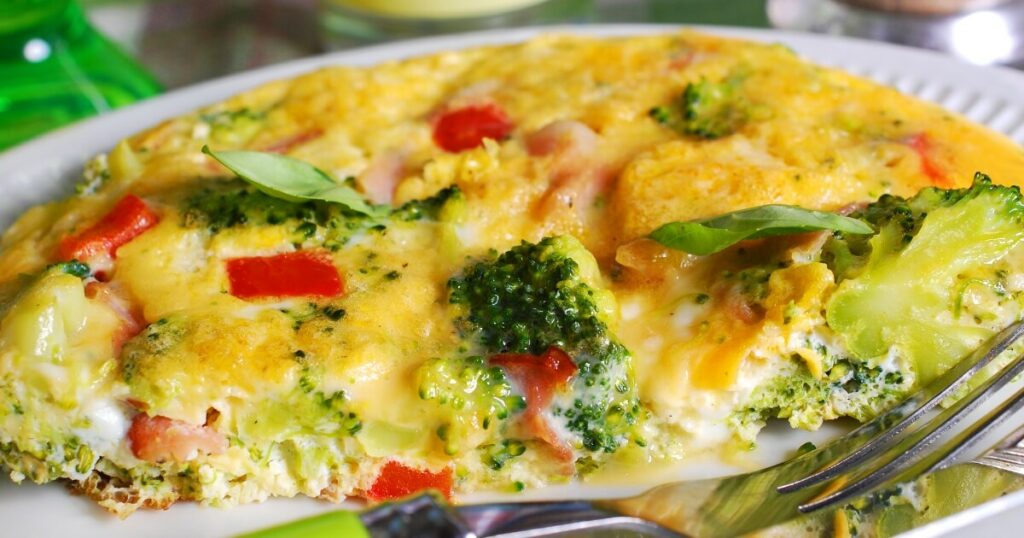A frittata is an egg-based Italian dish that might remind you of an omelet or a crustless quiche. It’s a versatile meal that can be enjoyed for breakfast, lunch, or dinner, and it’s enriched with ingredients such as meats, cheeses, and vegetables. But what exactly makes a frittata a frittata?
It’s creamy and custardy, full of the flavors of the ingredients you’ve chosen to include. Each bite is savory and fulfilling when combined with your favorite ingredients.
In this guide, I’ll explain what a frittata is, how it differs from other egg dishes, and how to make them better at home.
Ingredients Of A Frittata
A frittata starts with eggs, the base ingredient that binds everything together. But the beauty of a frittata lies in its flexibility. Beyond eggs, you can add various other ingredients based on your preferences and what you have.

Meats like ham, bacon, or sausage can add a hearty element to your frittata. If you’re a cheese fan, you can incorporate your favorites, whether cheddar, feta, or mozzarella. Vegetables also play a crucial role in a frittata.
You can use fresh or leftover veggies, such as bell peppers, onions, spinach, or tomatoes.
While these are some of the common ingredients, there’s no strict rule about what you can or cannot include in a frittata. It’s a dish that encourages creativity and experimentation.
You can try different combinations of ingredients or even themed frittatas, like a Mediterranean frittata with olives, feta cheese, and tomatoes or a breakfast frittata with bacon, cheese, and hash browns.
Variations and Customization Options
The versatility of a frittata extends to its cooking methods as well. You can cook a frittata on the stovetop, like an omelet, or bake it in the oven for a crustless quiche-like dish.
Some recipes even combine both methods, starting on the stovetop and finishing in the oven for a perfectly cooked frittata.
The size of the frittata can also vary. You can make a large frittata to feed a crowd or individual mini frittatas using a muffin tin.
Frittata vs. Other Egg Dishes
Egg dishes are a staple in many cuisines around the world, and while they share common ingredients, their preparation methods and final textures can vary greatly.
Let’s compare a frittata with other popular egg dishes: omelets, quiches, and scrambled eggs.
Frittata vs. Omelette

An omelet is typically made by beating eggs and cooking them quickly on high heat in a frying pan, adding fillings like cheese, vegetables, and meats.
The eggs are then folded over the fillings before serving. A frittata, on the other hand, mixes the ingredients with the eggs before cooking.
The cooking process is slower, often beginning on the stovetop and finishing in the oven, resulting in a more firm and set texture compared to the soft, slightly runny center of an omelet.
Frittata vs. Quiche

Quiche is another egg-based dish that’s similar to a frittata.
The main difference is that a quiche includes a crust and a custard filling made from eggs and cream, while a frittata is crustless and doesn’t typically include cream.
A quiche is usually baked in the oven, while a frittata can be cooked on the stovetop, in the oven, or both.
Frittata vs. Scrambled Eggs

Scrambled eggs are beaten and then cooked in a pan while being stirred or folded over low heat until they reach the desired level of doneness.
They’re often creamy and slightly runny, depending on personal preference. A frittata, however, is not stirred once the eggs are added to the pan. The eggs are allowed to cook slowly and evenly, resulting in a firm, custardy texture.
The ingredients in a frittata are mixed in with the eggs rather than served on the side, as they often are with scrambled eggs.
How Does a Frittata Taste?
Here are some common characteristics make a frittata a unique and enjoyable dish.
Taste
The taste of a frittata is largely determined by the ingredients you choose to include. The eggs form a mild, creamy base that carries the flavors of the other ingredients. If you add cheese, you’ll get a deliciously savory and sometimes tangy flavor.
Meats like ham or bacon will add a smoky, salty taste, while vegetables can bring a range of flavors, from the sweetness of bell peppers to the earthiness of mushrooms or spinach.
Texture
- Eggs: The eggs in a frittata are cooked slowly, resulting in a firmer texture than scrambled eggs or an omelet. The outside is often slightly crisp from being fried in the pan or baked in the oven, while the inside remains soft and custardy.
- Fillings: The texture of the fillings can add contrast and interest to the frittata. Crunchy vegetables, soft cheese, and chewy meats each contribute to the overall experience of eating a frittata.
Smell
The smell of a frittata cooking is a wonderful combination of the aroma of frying eggs, the savory scent of meat or cheese if you’re using them, and the fresh, appetizing smell of cooking vegetables.
If you’re using herbs or spices, they’ll add their own enticing aromas to the mix. The result is a mouthwatering scent that will rumble your stomach in anticipation of the meal to come.
How To Make a Frittata Taste Good
Making a delicious frittata is all about choosing quality ingredients and balancing flavors. Here are some tips to ensure your frittata tastes great:
Choose Fresh Ingredients
The fresher your ingredients, the better your frittata will taste. Fresh eggs, vegetables, and meats will give your frittata a clean, robust flavor. If you’re using cheese, opt for a good-quality variety that melts well.
Balance Your Flavors
A good frittata has a balance of flavors. If you’re using salty ingredients like bacon or cheese, consider balancing them with something sweet or tangy, like green bell peppers or tomatoes.
Similarly, if you’re using rich ingredients like sausage or cream, something light and fresh, like spinach or herbs, can provide a nice contrast.
Don’t Overcook
Overcooking can make the eggs in your frittata tough and rubbery. Cook your frittata just until the eggs are set but still soft and slightly creamy.
If you’re finishing your frittata in the oven, remember that it will continue to cook a bit after you take it out, so it’s better to err on the slightly underdone side.
Season Well
Don’t forget to season your frittata. A little salt and pepper helps in bringing out the flavors of your ingredients.
You can also add other seasonings for extra flavor such as garlic powder, onion powder, or herbs.
What Does a Frittata Look Like?

A frittata is a round, flat dish that resembles a thick pancake or a crustless pie. It’s typically cooked in a skillet or a round baking dish, which gives it its distinctive shape.
The top of a frittata is usually golden brown, often with visible pieces of the ingredients used, such as chunks of vegetables, bits of meat, or melted spots of cheese.
When you cut into a frittata, you’ll see a cross-section of the ingredients distributed throughout the egg mixture. Depending on the ingredients used, you might see colorful layers of vegetables, pockets of melted cheese, or pieces of meat. The inside of a frittata should look soft and slightly creamy, not dry or crumbly.
If you’re buying a pre-made frittata at the grocery store, look for one that has a vibrant, golden color and visible pieces of fresh-looking ingredients. It should be firm to the touch but not hard or overly dry.
Avoid frittatas that look pale and soggy or that have ingredients that appear wilted or discolored.
Remember, the best frittatas are usually the ones you make at home, where you can control the quality and freshness of the ingredients. But whether you’re making or buying a frittata, now you know what to look for!
Recipes And Side Dishes
Here are some popular recipes and side dish recommendations to complement your frittata:
Frittata Recipes
- Vegetable Frittata: This is a great option for a light and healthy meal. Mix your favorite vegetables like bell peppers, onions, spinach, and tomatoes. Add some feta or goat cheese for a tangy flavor.
- Bacon and Cheese Frittata: Add cooked bacon and a generous amount of cheese like cheddar or mozzarella for a hearty frittata. This combination is a classic that’s sure to please.
- Mediterranean Frittata: For a taste of the Mediterranean, include ingredients like olives, tomatoes, feta cheese, and fresh herbs like basil or oregano.
Side Dishes
- Salad: A fresh salad is a perfect side dish for any frittata. It adds a refreshing contrast to the rich, eggy frittata. Try a simple green salad or something more elaborate, like a Greek salad or a Caprese salad.
- Bread: A chunk of crusty bread is great for scooping up any leftover bits of frittata. You can also make toast or garlic bread for a more flavorful option.
- Roasted Potatoes: Potatoes are a hearty side that pairs well with frittatas. Try roasting them with some olive oil, salt, and your favorite herbs for a delicious and satisfying side dish.
- Fruit: Serve your frittata with some fresh fruit for a lighter side. This could be as simple as a few slices of your favorite fruit or a mixed fruit salad.
Are Frittatas Healthy?
Frittatas can be a healthy meal option, depending on the ingredients you choose. They are high in protein thanks to the eggs and can be packed with nutrients if you add a variety of vegetables.
Eggs, the main ingredient in a frittata, are a great source of high-quality protein. They also provide important vitamins and minerals, including vitamin B12, vitamin D, and selenium.
Adding vegetables to your frittata will give you additional fiber, vitamins, and minerals. Cheese or meat can add extra protein, but be mindful of the fat and sodium content.
The Role of Frittata In Italian Cuisine
The frittata holds a special place in Italian cuisine as a simple, versatile, and economical dish. It’s often made with leftovers, making it a practical and sustainable choice that reduces food waste.
Frittatas can be served at any meal, from a quick breakfast to a light lunch or dinner, and they’re a common choice for picnics since they can be enjoyed hot or cold.
The frittata’s cultural significance extends beyond Italy. It’s become popular worldwide, with many cultures adopting and adapting the dish to suit local tastes. In Spain, for example, a similar dish called a tortilla española is a staple, typically made with potatoes and onions.
In the United States, frittatas are often loaded with various fillings, from vegetables and cheeses to meats and seafood.
Frittata FAQs
What is the difference between an omelet and a frittata?
An omelet is made by quickly cooking beaten eggs in a pan and folding them around fillings like cheese, vegetables, or meats. A frittata, on the other hand, mixes the ingredients with the eggs before cooking, and the cooking process is slower, often starting on the stovetop and finishing in the oven.
What is the difference between a quiche and a frittata?
The difference between a quiche and a frittata is that a quiche includes a crust and a custard filling made from eggs and cream, while a frittata is crustless and doesn’t typically include cream.
What makes a frittata a frittata?
A frittata is an egg-based dish that includes additional ingredients like meats, cheeses, and vegetables. The ingredients are mixed with the eggs before cooking, and the dish is cooked slowly, often starting on the stovetop and finishing in the oven.
How does a frittata differ from scrambled eggs?
Scrambled eggs are cooked by stirring or folding the eggs over low heat until they reach the desired level of doneness. A frittata, however, is not stirred once the eggs are added to the pan. The eggs are allowed to cook slowly and evenly, resulting in a firm, custardy texture.
What are the main ingredients in a traditional frittata?
The main ingredients in a traditional frittata are eggs, meats, cheeses, and vegetables. However, the specific ingredients can vary widely depending on personal preference and regional variations.
My Tasty Thoughts
Frittatas really show off the simplicity in cooking, where a few quality ingredients can come together to create something truly delicious.
Whether you’re a fan of meat and cheese or prefer a medley of fresh vegetables, there’s a frittata recipe for you. The possibilities are endless, and the process is straightforward enough for cooks of all skill levels.